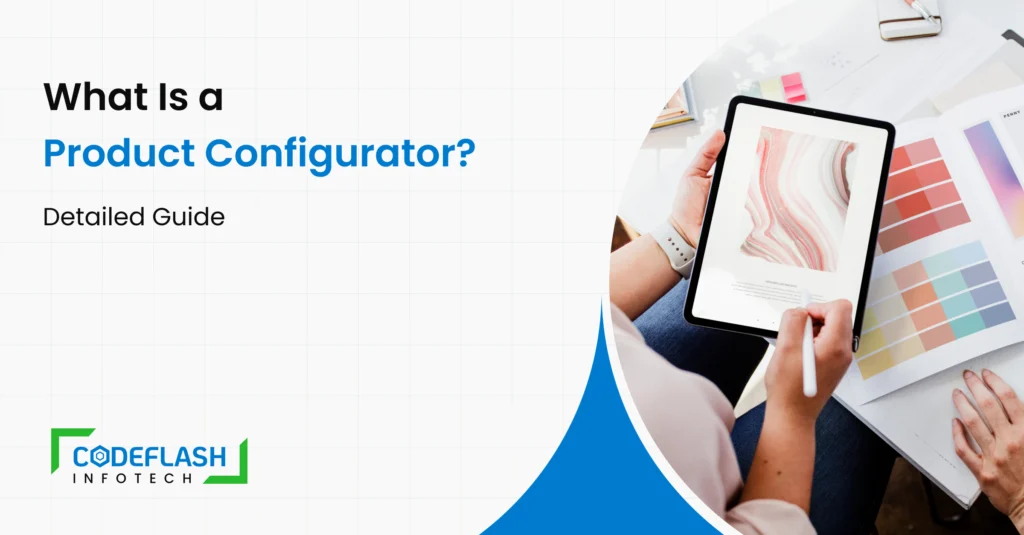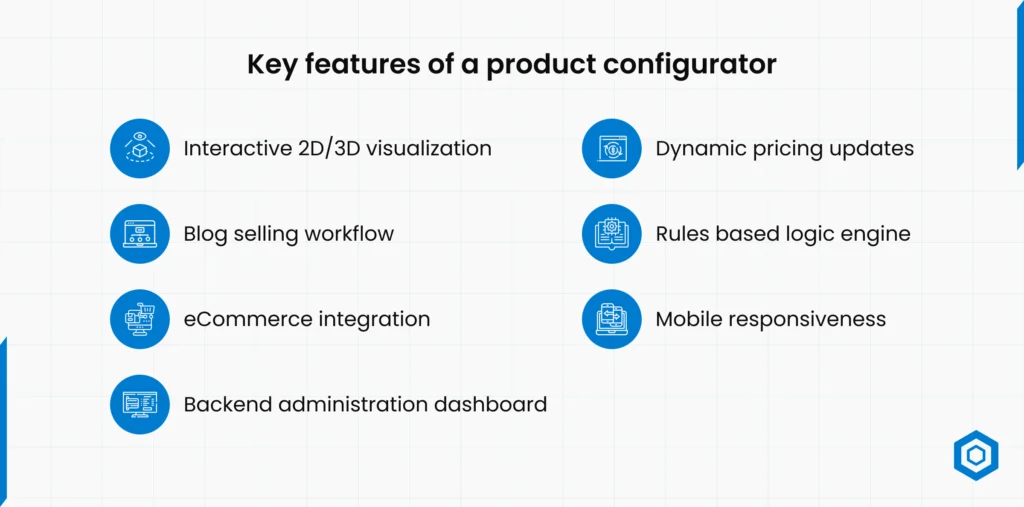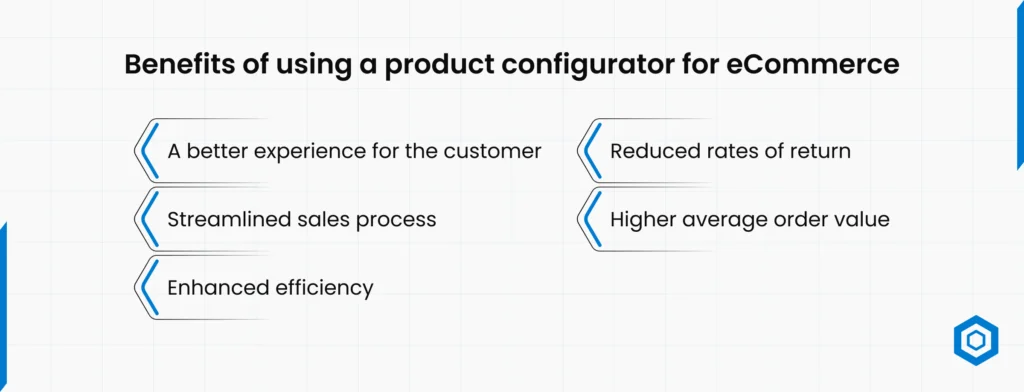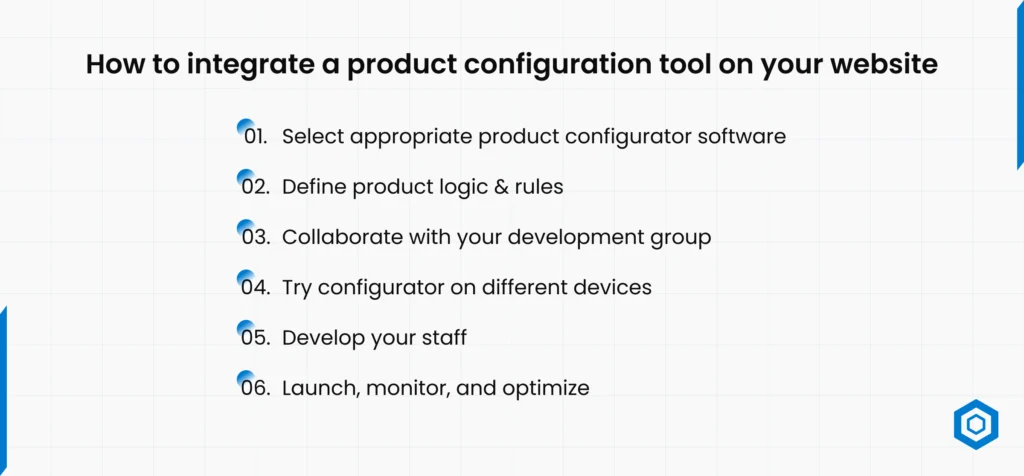
What Is a Product Configurator? A Detailed Guide
19 SEPTEMBER
A product configurator is a powerful digital tool that enables customers or businesses to customize products in real-time, selecting designs, features, colors, and specifications that match their exact needs.
Instead of browsing through static options, users can interactively build a product the way they want-making the buying process more personalized, engaging, and efficient. From manufacturing to retail and beyond, product configurators are revolutionizing the design, sale, and experience of products.
A report by Statista has found that customers are more than 50% likely to purchase from a retailer offering a personalised experience. Product configuration tools are fundamentally changing the way businesses merchandise, from selecting the interior finish of a car to customising furniture or consumer electronics.
Product configuration tools enable customers to create what they want, how they want. Companies benefit by differentiating their brands, reducing errors, and ultimately driving more conversions.
This is a detailed Blog on how product configurator software solutions work for different industries. The blog covers what a product configurator is and how it works, the features included, the benefits provided, and how to integrate a product configurator on your website to drive business growth.
What Is a Product Configurator?
A product configurator is an interactive interface that allows a customer to personalise their products by choosing features, colours, sizes, and other alternatives. Product configurators often take the form of projects available for B2B programs, online shopping, and manufacturing.
Furthermore, product configurators give the customer a visual view of their selections, which can significantly improve the customer’s shopping experience.
So it simplifies everything, showing only what can work together and updates being applied immediately. The Configurator, which ensures consumers know precisely what they are buying, is as true for electronics and other devices as it is for furniture or clothes.
2D, 3D, and augmented reality product customizers help you to visualise each inch of a product in much greater detail. The 3D product configurator provides customers with a realistic experience by allowing them to interact with the product online. This gives customers more faith in the product and reduces returns by a considerable amount.
How Does a Product Configurator Work?
Product configurators use engines based on dynamic rules to filter and update options based on customer preferences. ERP-integrated inventory management delivers real-time data. The app instantly updates availability and pricing as users make selections.
Many configurators also offer guided selling solutions that Blog customers through every step of the process. Using these product builder tools, they ask the user questions to help hone in on the best options based on the needs of the customer. The goal is to increase sales while making the consumer happy.

Key Features of a Product Configurator
Strategic product configurators simplify user and corporate lives. Let’s examine the key features that make these tools valuable for companies in the current digital market.
- Interactive 2D/3D Visualization
This shows them how the product will look when designed in real time. 2D and 3D models allow for more visualisation of the colours, materials, and changes to style.
By doing this, you can show prospective customers what they get, and the payoff is likely to be an increased level of trust in buying, along with a substantial reduction in post-fill return rate.
- Dynamic Pricing Updates
Then our price automatically adjusts in case users add or drop features. This linearity keeps the confusion or fees causal to it at bay. It opens up a plethora of possibilities for businesses in terms of upselling, as they demonstrate the value of each adopted feature.
- Blog Selling Workflow
The Blog selling solution takes users through a unique solution process (because one requires and wants a solution according to their own needs). It also provides users with the best alternatives based on suitability, thereby enhancing the user experience and making it accessible to non-expert users. The skill, for those of us who struggle with decision-making, automates and accepts the food-buying processes.
- Rules-Based Logic Engine
Ensure valid combinations via a rule-based logic engine and prevent customization choice clashes. Enforcing smart limits. Development on the logical engine side saves development time and should be done by the user only.
One possible approach is to implement sensible limitations within the user space, where most of the logic resides.
- Integration with eCommerce Platforms
A good product setup tool works perfectly with popular eCommerce systems like Shopify, Magento, and WooCommerce. This ensures smooth checkout processes and inventory updates. It creates a unified system that supports real-time orders and pricing.
- Mobile Responsiveness
With a mobile-friendly setup, they can complete their product setup and place their order from anywhere, at any time. This elasticity provides a better user experience and helps increase mobile conversion rates.
- Backend Administration Dashboard
Administrators control pricing, options, logic rules, and graphics from a single dashboard. This simplifies updating product offerings without writing code. It enables agility and allows businesses to keep up with market demands.

Benefits of using a product configurator for eCommerce
Here is how a product configuration solution for your eCommerce activities can improve the way you operate, from increased levels of productive engagement through to order management.
- A better experience for the customer
Customers expressed a need to Feel In Control and were content to see items in person before confirming purchases and personalising their products. At the same time, blogs are a customer favourite with the ability to custom-tailor a purchase experience.
- Reduced Rates of Return
When customers realise precisely what they are purchasing, they are far less likely to be disappointed. Returns for the wrong size, colour, or specification will then considerably decrease.
- Streamlined Sales Process
A product customizer streamlines the purchasing process by enabling customers to create their ideal product in a self-service environment. This minimises the need for back-and-forth communication with sales teams. For B2B and complex product models, this also accelerates quote generation and results in quicker sales closures.
- Higher average order value
The more choices people have, the more likely they are to buy an extra, an update, or a premium feature. Given an opportunity to observe the pricing live, these sorts of add-ons feel transparent and fair. This naturally pushes the average order value up slowly without being invasive/sales-focused.
- Enhanced Efficiency
Business Rules allow clean orders (orders that are true and can be fulfilled) to progress through various Business Rules based on logic, data flow, and completion of actions. It reduces the number of mistakes in the manufacturing and fulfilment process, and prevents you from depending on a manual check.
It also means that teams can focus on more valuable tasks, a far better use of their time than dealing with misconfigurations.

How to integrate a product configuration tool on your website
A product configurator for your website must be Custom-made to your platform, product catalogue, and user flow. The way it integrates smoothly with Shopify, Magento, WooCommerce, or even your Custom CMS ensures its usability and backend performance. Here is an overview of 6 key steps to integrate a product configuration tool into your general e-commerce platform.
- Select Appropriate Product Configurator Software
Select a solution that accommodates your frontend/backend tech stack, catalogue size, and industry. They work with your current CMS or ERP and offer price logic, blog selling, and free and paid choices for 2D or 3D showcases. Additionally, make sure the tool is responsive on mobile devices and supports the current database or product feeds.
- Define Product Logic & Rules
Describe your matrix to customise product elements. Customizability, options, and interdependence? That is how, for example, 3D product configurators or Blog selling platforms work: they rearrange the view and pricing by using one of these logics.
- Collaborate with Your Development Group
Developers need to develop this against any of the product customizer SDKs or APIs. Plugins are available for platforms such as WooCommerce or Magento, which makes the setup easier. All of the selections you have made on the frontend are accurately displayed in these invoices, order system, and CRM due to their backend integration.
- Try Configurator on different Devices
Before you go live, remember to test the tool with several browsers, screen sizes, and use cases. So even when users are playing with dynamic pricing ticks or high-res 3D models, there is a sense of continuity. But user testing is critical because poor performance of a sluggish or confusing user interface can decrease engagement.
- Develop Your Staff
The people who take sales calls and the customer support team should know the configuration system. If that’s technology your sales team relies on as part of your blog-selling strategy, make sure your salespeople are prepared to use it on calls and demos.
- Launch, Monitor, and Optimise
Track how users comfortably interact through the Configurator, track engagement metrics and cart abandonment rates, even AOV (Avg Order Value) post launch. Take this information and continue to improve the logic and user experience, experiment with A/B testing new features or design elements to improve performance over time.
Challenges and Things to Think About
Implementing a Product Configurator will have some challenges. These issues can effectively limit the performance and adoption of the solution.
- Backend Integration Issues
In addition, configuration has never been more challenging than the recent integration of the Configurator with prices, inventory levels, and CRM systems. In short, by doing this, they could avoid the risk of incorrect promo pricing & order fulfillment issues due to data sync.
- Complex User Interfaces
A tool that users may refuse to use if the tool is too hard to stomach. Customers who find too many customisation options or a complex interface can become overwhelmed. The user interface must allow for real-time feedback, be easy to navigate, and enable a few steps.
- Expensive to Develop and Sustain
If you want to develop an in-house custom configurator with technology such as AR or 3D previews, that can be very expensive. Since it needs to be consistently developed, maintained, and updated, it requires fixing bugs and ensuring compatibility with other libraries. Businesses will also need post-build investment, in addition to the initial build.
- Browser and Device Compatibility
With multiple devices from smartphones to tablets, desktop computers, and everything in between, users are running different browsers on an array of screen sizes. The Configurator will be necessary, but it is also challenging to keep it working on all platforms.
- Performance and Load Time Issues
Having a page full of heavy visuals, real-time 3D rendering, or dynamic content can slow the page down. A slow configurator will make shopping less fun (because it’s just slow). If the pages take too long to load, people can leave their shopping carts. You can speed up the process by optimising and delivering the content using some strategies.
Conclusion
Online shopping has changed as a result of its increased freedom, power, and personalisation. These tools allow you to interact in real time with a 3D model of a shoe or a custom-built sofa. This lets you buy things that you like. Hire a product configurator developer from Codeflash Infotech.
As the number of online stores continues to increase, having a good tool for customising items can provide you with a competitive edge. Product configurators (the technical term for customisation) are invaluable to today’s business model since they can boost sales and lower returns.

Frequently Asked Questions
A product configurator enables customers to personalize products in real-time, allowing them to visualize changes instantly. This reduces uncertainty, builds confidence in their purchase, and leads to higher satisfaction.
Yes. Most modern product configurators can be seamlessly integrated with popular e-commerce platforms, such as Shopify, Magento, or WooCommerce, ensuring smooth order management, inventory updates, and pricing synchronization.
No. Small and medium businesses can also benefit from product configurators. Cloud-based and SaaS options make it affordable to offer customization without heavy upfront investment.
Industries such as furniture, fashion, automotive, jewelry, electronics, and even SaaS software providers utilize configurators to enable customers to tailor products to their specific needs.
Not always. While 3D models provide an immersive experience, 2D visuals, dropdown menus, and text-based options can also be used, depending on the complexity of the product.
They reduce cart abandonment by allowing customers to see exactly what they’re buying. This transparency fosters trust, boosts conversions, and often results in higher average order values.




